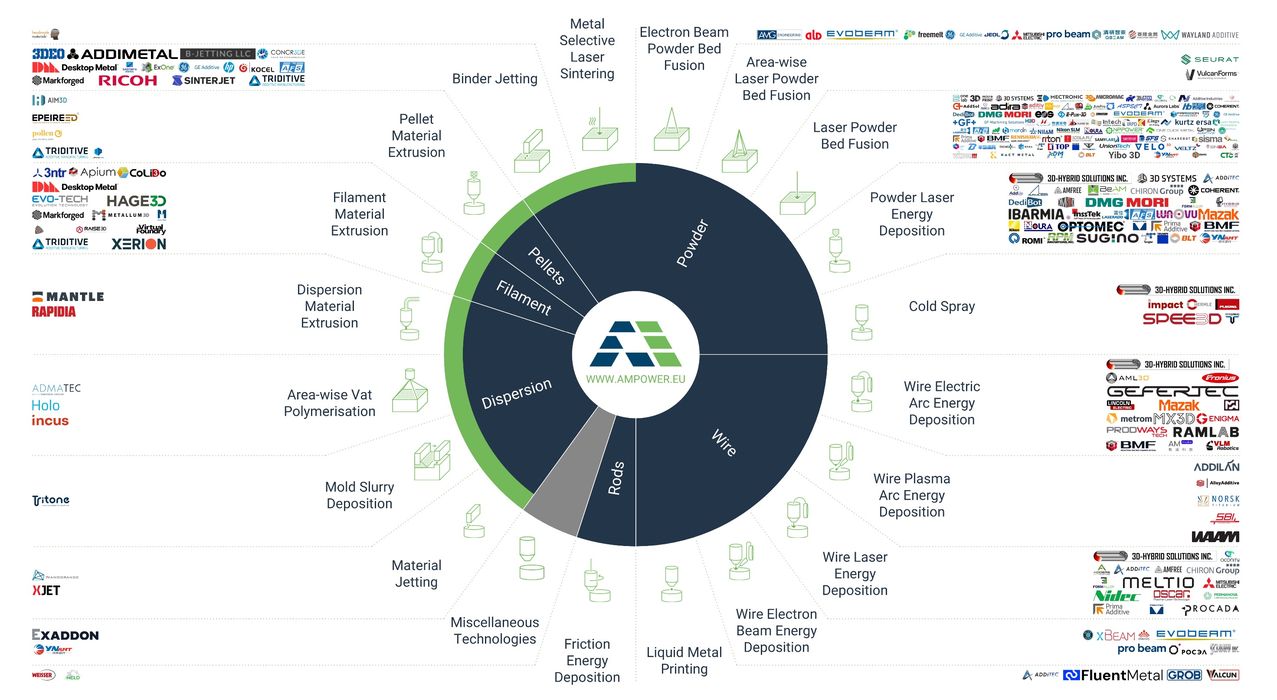
AMPOWER has issued a new version of their famous metal 3D print technology vendor chart.
The well-known consulting company has been producing “technology maps” for several years. They offer three maps, one for metal technologies, and one for each of polymer and ceramic technologies.
The company provides detailed PDFs of each for download, and they also hand out large format printed copies at major trade shows.
They’ve just updated the metal chart, and it’s quite interesting to browse.
They’ve organized it around the ever-increasing methods of metal 3D printing. While the standards associations describe only seven methods, those can be broken down into multiple other sub-methods, which is how AMPOWER categorizes technologies.
Here is their current list of metal 3D printing technologies holds 19 categories:
- Metal Selective Laser Sintering
- Binder Jetting
- ElectronBeam Powder Bed Fusion
- Area-wise Powder Bed Fusion
- Laser Powder Bed Fusion
- Powder Laser Energy Deposition
- Cold Spray
- Wire Electric Arc Energy Deposition
- Wire Plasma Arc Energy Deposition
- Wire Laser Energy Deposition
- Wire Electron Beam Energy Deposition
- Liquid Metal Printing
- Friction Energy Deposition
- Material Jetting
- Mold Slurry Deposition
- Area-wise Vat Polymerization
- Dispersion Material Extrusion
- Filament Material Extrusion
- Pellet Material Extrusion
- Miscellaneous Technologies
Well, there’s actually 20+ categories if you count “miscellaneous”.
My point here is that it’s easy to say that the technology is stable and mature, but that’s hardly the case. New entries on these technology maps occur all the time. If one were to take a look at the equivalent chart from ten yeas ago, it would be less than half the size with far fewer technologies.
It’s very likely we will see even more categories arrive on future technology maps as startups come forward with new and ingenious approaches to metal 3D printing.
There’s one more interesting twist to this chart. If you look closely, you’ll see that only a few of the technologies have larger numbers of providers. The leading technologies seem to be:
- Laser Powder Bed Fusion
- Powder Laser Energy Deposition
- Binder Jetting
- Filament Metal Extrusion
- Wire Electric Arc Energy Deposition
- Wire Laser Energy Deposition
By far the majority of 3D printing companies offer those technologies. But that doesn’t mean the rest are in the wrong place. Many of the lesser-used technologies are still getting off the ground, and several have patent protection, preventing other companies from using that approach.
My suspicion is that over time we will see technologies that offer true scalable and efficient metal 3D printing come to dominate the space. Metal 3D printing is inherently used for production end-use parts, and that will require the ability to efficiently produce large quantities of parts.
Finally, it’s incredible to see the sheer number of companies involved in metal 3D printing. It was only a few years that this chart would have been quite substantially smaller.
Metal 3D printing continues to grow, and AMPOWER’s chart confirms this.
Via AMPOWER
